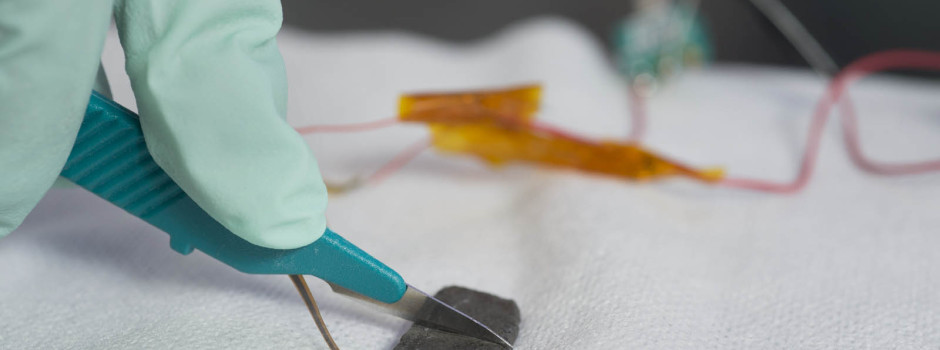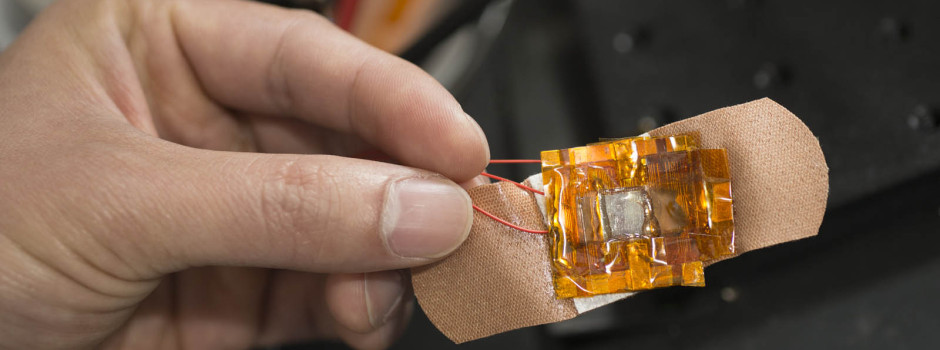Imagine trying to emulate what human skin does to protect and heal our bodies. Not only is our skin sensitive, sending the brain information about pressure and temperature, but it heals efficiently to maintain a protective barrier. Combining these two features into one synthetic material has been the focus of Stanford chemical engineering professor Zhenan Bao and her team. The team has now succeed in making a synthetic “skin” that is not only sensitive to touch, it is capable of healing itself quickly and repeatedly at room temperature. This has significant implications for the biomedical textile markets.
In the last decade, there have been major advances in synthetic skin, Bao says, but even the most effective self-healing materials had drawbacks. Some had to be exposed to high temperatures, making them impractical for day-to-day use. Others could heal at room temperature, but repairing a cut changed their mechanical or chemical structure, so they could only heal themselves once. Most importantly, no self-healing material was a good bulk conductor of electricity.
“To interface this kind of material with the digital world, ideally you want them to be conductive,” said Benjamin Chee-Keong Tee, first author of the paper.
“Magic” ingredient
The researchers succeeded by combining two ingredients to get what Bao calls “the best of both worlds”—the self-healing ability of a plastic polymer and the conductivity of a metal. They started with a plastic consisting of long chains of molecules joined by hydrogen bonds—the relatively weak attractions between the positively charged region of one atom and the negatively charged region of the next.
“These dynamic bonds allow the material to self-heal,” said Chao Wang, a co-first author of the research. The molecules easily break apart, but then when they reconnect, the bonds reorganize themselves and restore the structure of the material after it gets damaged, he said. The result is a bendable material, which even at room temperature feels a bit like saltwater taffy that has been refrigerated.
To this resilient polymer, the researchers added tiny particles of nickel, which increased its mechanical strength. The nanoscale surfaces of the nickel particles are rough, which proved important in making the material conductive. Tee compared these surface features to “mini-machetes,” with each jutting edge concentrating an electrical field and making it easier for current to flow from one particle to the next.
The result was a polymer with uncommon characteristics. “Most plastics are good insulators, but this is an excellent conductor,” Bao said.
Faster than skin
The next step was to see how well the material could restore its mechanical strength and electrical conductivity after damage. Using a scalpel, the researchers cut a thin strip of the material in half. After gently pressing the pieces together for a few seconds, they found the material gained back 75 percent of its original strength and electrical conductivity. The material was restored close to 100 percent in about 30 minutes.
“Even human skin takes days to heal. So I think this is quite cool,” Tee says. What’s more, the same sample could be cut repeatedly in the same place. After 50 cuts and repairs, a sample could withstand bending and stretching just like the original.
The composite nature of the material created a new engineering challenge for the team. Bao and her co-authors found that although nickel was key to making the material strong and conductive, it also got in the way of the healing process, preventing the hydrogen bonds from reconnecting as well as they should. According to Bao, the size and shape of the nanoparticles, or the chemical properties of the polymer, could be adjusted to overcome this.
Touch sensitive
The team also explored how to use the material as a sensor. For the electrons that make up an electrical current, trying to pass through this material is like trying to cross a stream by hopping from stone to stone. The stones in this analogy are the nickel particles, and the distance separating them determines how much energy an electron will need to free itself from one stone and move to another.
Twisting or putting pressure on the synthetic skin changes the distance between the nickel particles and, therefore, the ease with which electrons can move. These subtle changes in electrical resistance can be translated into information about pressure and tension on the skin.
Tee says that the material is sensitive enough to detect the pressure of a handshake. It might, therefore, be ideal for use in prosthetics, Bao said. The material is sensitive not only to downward pressure but also to flexion, so a prosthetic limb might someday be able to register the degree of bend in a joint.
There are other commercial possibilities: Electrical devices and/or wires coated in this material could repair themselves and get electricity flowing again without costly and difficult maintenance, particularly in hard-to-reach places, such as inside building walls or vehicles.
The team’s goal is to make the material stretchy and transparent, so that it might be suitable for wrapping and overlaying on electronic devices or display screens.
 TEXTILES.ORG
TEXTILES.ORG




